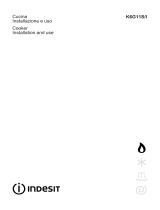
12
Advice and recommendations
• This appliance was designed for non-professional,
household use.
• Before using the appliance, read the instructions in the
owner’s manual carefully since it contains all the instruc-
tions you require to ensure safe installation, use and
maintenance. Keep this owner’s manual in a safe place
for future reference.
• When you have removed the packing, check whether
the appliance is intact. If you have any doubts, contact a
qualified professional before using the appliance.
• Never leave the packing components (plastic bags, poly-
styrene foam, nails, etc.) within the reach of children
since these are a source of potential danger.
• The appliance must be installed by a qualified techni-
cian in compliance with the instructions provided by the
manufacturer.
• The latter denies all responsibility for improper installa-
tion which may harm persons and animals and damage
property.
• The electrical safety of this appliance can only be guar-
anteed if the latter is correctly and efficiently earthed, in
compliance with regulations on electrical safety. Always
ensure that this vital safety measure has been taken. If
you have any doubts, call in a qualified technician to
check the electrical system thoroughly.
• The manufacturer denies all responsibility for damage
resulting from a system which has not been earthed
correctly.
• Before powering the appliance, check whether the tech-
nical characteristics featured on the appliance data plate
correspond with those of the mains electrical system.
• Check that the current load of the mains supply and of
the power sockets is suitable for the maximum power of
the appliance, indicated on the appliance data plate. If
in doubt, contact a qualified professional.
• This appliance must only be used for the purpose for
which it was expressly designed. Any other use (such
as heating a room for example) is considered to be im-
proper and consequently dangerous.
• The manufacturer denies all responsibility for damage
resulting from improper or incorrect use of the appli-
ance.
First use: the glue used on the hob seals may leave greasy traces on the glass surface. We recommend you wipe
these off before using the appliance, with the aid of a non abrasive cleaner. During the first few hours of use, you may
detect a smell of rubber, which will disappear quickly.
• Certain fundamental rules must be followed when using
electrical appliances. The following are of particular im-
portance:
• do not touch the appliance with wet or damp hands,
• never use the appliance when barefoot,
• never use extensions,
• never pull on the power supply cable or the appliance
itself to unplug it from the mains socket,
• never leave the appliance exposed to atmospheric
agents (rain, sun, etc.),
• do not allow children or persons who are not familiar
with the appliance to use it without supervision.
• Always unplug the appliance from the mains or switch
off the main switch before cleaning or performing any
cleaning or maintenance operations.
• If the surface of the glass cracks, unplug the appli-
ance immediately. For any repairs, contact only an au-
thorised after-sales service centre and demand original
spare parts. Failure to comply with the above may com-
promise the safety of the appliance.
• Cut the power supply cable after disconnecting it from
the power mains when you decide not to use the appli-
ance any longer. Also make all potentially dangerous
parts of the appliance safe, above all for children who
could play with the appliance.
• The glass ceramic hob is resistant to thermal and me-
chanical shocks. However, it may break due to a shock
caused by a sharp object, such as a tool for exam-
ple. In this case, unplug the appliance immediately
and contact an authorised after-sales service cen-
tre to have it repaired.
• Remember that the heating area stays hot for at least
half an hour after being turned off; please refrain from
placing any cookware or other items on the cooking zone
while still hot.
• Do not turn on the heating zones if aluminium foil or
plastic items have been placed on the hob surface.
• Do not go near the heating zones when these are still
hot.
• If you use small electric appliances near the hob, make
sure their power supply cable does not come into con-
tact with the hot parts of the hob.
• Make sure all pan handles are always pointing inwards
towards the centre of the hob to prevent any accidental
spills.
• WARNING: Do not look at the halogen lamps in
the cooking zones for long if they are present.









